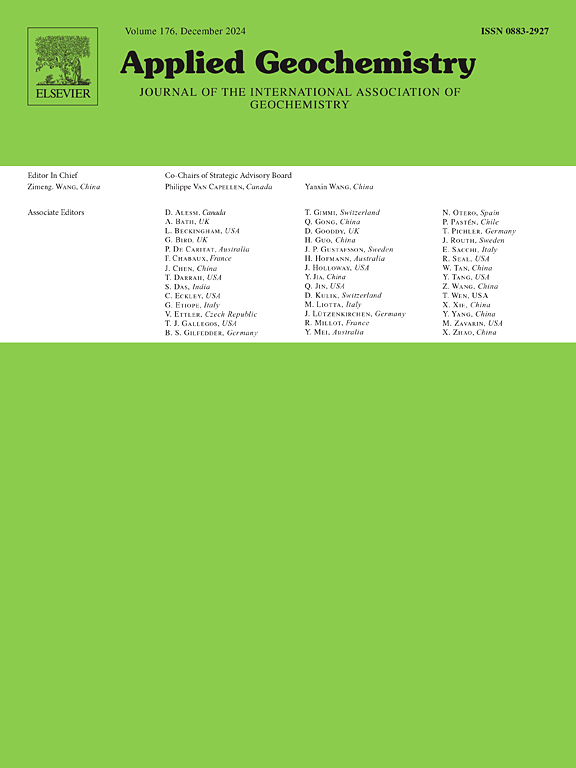冰岛㱮斯塔雷基尔热液中的岩浆和岩石浸出对金属负荷的贡献
IF 3.1
3区 地球科学
Q1 GEOCHEMISTRY & GEOPHYSICS
引用次数: 0
摘要
岩浆-热液系统是研究元素从地球深部向地表转移以及元素在地壳内的动员和再分布的关键环境。这些系统被认为是矿石沉积的潜在活跃模拟场所。流体及其金属负荷的来源分为两部分,一部分来自下伏岩浆的脱气作用,另一部分来自热液与主岩之间的相互作用。在这里,我们结合对þeistareykir地热田(冰岛东北部)流体和岩石中惰性气体和挥发性金属的分析,对这两种来源的相对贡献提供了约束。氦同位素数据表明,80%-85%的氦来自岩浆脱气。经大气污染校正后的 3He/4He 比率(Rc/Ra)与地表流体中的挥发性金属丰度相关,表明铋和汞主要来自岩浆脱气。此外,利用岩浆脱气和水岩相互作用的元素特征还表明,深层地热储层流体中除 Mn、Fe、Co、Cu、Ti 和 V 外,主要由岩浆输入。各井之间 Rc/Ra 和地表流体挥发性金属含量的空间变化表明,当地和区域结构对流体从深层到地表的路径产生了影响。本文章由计算机程序翻译,如有差异,请以英文原文为准。

Magmatic and rock-leaching contributions to the metal load in hydrothermal fluids at þeistareykir, Iceland
Magmatic-hydrothermal systems are key environments to study the transfer of elements from the deep Earth to the surface and the mobilization and re-distribution of elements within the crust. These systems have been recognized as potential active analogue sites for ore deposition. The source of fluids and their metal load is split between the relative contributions from degassing of underlying magma and interactions between the hydrothermal fluid and the host rock. Here, we combine analyses of noble gases and volatile metals in fluids and rocks from the þeistareykir geothermal field (NE Iceland) to provide constraints on the relative contribution of these two sources. Helium isotope data suggest 80–85% originated from magma degassing. The 3He/4He ratio, corrected for atmospheric contamination (Rc/Ra) correlates with volatile metal abundances in surface fluids and indicates that Bi and Hg are predominantly derived from magma degassing. It is also shown that the deep geothermal reservoir fluid is dominated by magmatic input, except for Mn, Fe, Co, Cu, Ti and V, using the elemental signature of magmatic degassing and water-rock interaction. The spatial variations in Rc/Ra and surface fluid volatile metal contents among the wells suggest an impact of the local and regional structures on the fluid's pathway from depth to surface.
求助全文
通过发布文献求助,成功后即可免费获取论文全文。
去求助
来源期刊

Applied Geochemistry
地学-地球化学与地球物理
CiteScore
6.10
自引率
8.80%
发文量
272
审稿时长
65 days
期刊介绍:
Applied Geochemistry is an international journal devoted to publication of original research papers, rapid research communications and selected review papers in geochemistry and urban geochemistry which have some practical application to an aspect of human endeavour, such as the preservation of the environment, health, waste disposal and the search for resources. Papers on applications of inorganic, organic and isotope geochemistry and geochemical processes are therefore welcome provided they meet the main criterion. Spatial and temporal monitoring case studies are only of interest to our international readership if they present new ideas of broad application.
Topics covered include: (1) Environmental geochemistry (including natural and anthropogenic aspects, and protection and remediation strategies); (2) Hydrogeochemistry (surface and groundwater); (3) Medical (urban) geochemistry; (4) The search for energy resources (in particular unconventional oil and gas or emerging metal resources); (5) Energy exploitation (in particular geothermal energy and CCS); (6) Upgrading of energy and mineral resources where there is a direct geochemical application; and (7) Waste disposal, including nuclear waste disposal.
 求助内容:
求助内容: 应助结果提醒方式:
应助结果提醒方式:


